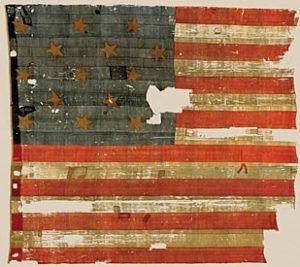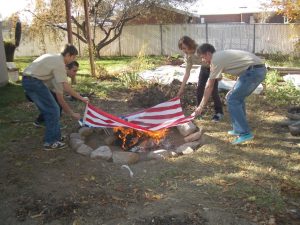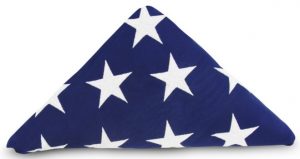Disposing of Worn-out Flags

Torn, tattered and frayed United States Flags should be replaced, but what should be done with the worn-out flags?
John Hartvigsen
Of questions we are asked, one recurring subject focuses on withdrawing worn-out flags from use. Flags are made to be flown in wind, sun and foul weather; therefore, they will tear, fray and fade with use. That is true for U.S. flags, foreign flags, state flags, municipal flags, company flags and club flags. When a flag wears out, it should not be flown, but how do we dispose of it properly?
There is a simple answer, but like most simple answers it does not work in all circumstances.
When we think about “retiring” the Stars & Stripes, the United States Flag Code gives the flowing guidance:
The [United States] flag, when it is in such condition that it is no longer a fitting emblem for
display, should be destroyed in a dignified way, preferably by burning.
(Title 4 U.S. Code § 8, Paragraph k)
Simple? True enough—if someone has a 3’ by 5’ cotton U.S. flag that they have displayed at home. In years past it was simple to privately burn the worn flag in the back yard without ceremony. Destroying the flag by burning was the convenient method to ensure that it would not end up tossed on a garbage heap or used for a secondary purpose.
Nevertheless, details can make disposing a U.S. flag today by burning more of a challenge.
- Burning a flag my not be allowed by subdivision restrictions, local regulations or laws.
- Home owners or city dwellers may not have a means or place to burn a flag.
- Synthetic fibers may melt before burning.
- Synthetic cloth may and give off noxious fumes when burned.
- Larger flags may be too unwieldy to safely burn.
What then are alternative ways to respectfully dispose of worn out United States flags?
Options vary according to community location. Here are some options to check out:
- Retailers may offer a service to properly dispose of worn-out U.S. flags. Colonial Flag Company, for example, accepts worn-out U.S. flags at their Showroom and will even offer a discount on the purchase of a replacement flag.
- Service organizations may accept worn-out U.S. flags and sponsor events to destroy collected flags respectfully.
- Veterans organizations often have programs to accept and correctly destroy worn-out U.S. flags.
- Scout troops and members may collect worn-out U.S. flags as a service project and to use in teaching fellow scouts how to appropriately burn them following guidance of the U.S. Flag Code.
Is there an authorized ceremony for the disposing of worn-out U.S. flags by burning?
Early versions of the flag code and military regulations advised that destroying worn-out U.S. flags could be done by burning or burying them privately without ceremony.
More recently, ceremonies have been created as part of patriotic programs to destroy flags collected by various organizations. These ceremonies vary in detail; however, none are required and none are official. The U.S. Flag Code is silent on these types of ceremonies. The stated requirement is always to show respect for the Flag of the United States of America.
What are some differing details that are part of flag “retirement” ceremonies?
- Cutting the U.S. flag apart into three parts—the Union of stars, the six long stripes and the seven short stripes. Some suggest that a flag dismembered in this fashion is no longer an “official” flag, and may then be burned. Others make burning the separate pieces part of the ceremony.
- Holding large ceremonies or programs to burn large numbers of U.S. flags collected over a period. While these events are not required, they are not discouraged. Americans have a desire to honor the flag, and over the years ways to do this have expanded.
- Although U.S. flag can burn well when held out flag over a flame, some organizers of these event may believe that a flag must be folded into the triangular fold before burning. It takes a lot of heat and fire to burn folded flags, and, if made of synthetic fabric, they are more likely to melt and produce noxious smoke and fumes.
- The Union of stars is sometimes cut into individual stars that are presented to veterans or other people to be honored. While this may be considered a secondary use, it actually follows an old tradition of “souveniring” flags. Cutting pieces of flags for souvenirs usually happened for historically important flag; nevertheless, presenting individual stars cut from a flag follows the spirit of this old custom.
Throughout this article, disposing of U.S. flags has been considered, but what about state, local and other flags?
It would surprise most Americans to see the large numbers of worn-out U.S. flag that are gathered awaiting proper disposal. American love to fly flags, and flags wear out; however, those who provide the needed and appreciated service for worn-out flag disposal, may be unable or unwilling to accept state, local and other flags. Simply tossing these flags in the garbage doesn’t show proper respect, but how can it be done properly?
We can look to how flag disposal is done in other countries where burning of worn-out flag is not practical or even possible. In countries where flags may be a bi-color or tricolor, such as Austria, France, Germany, the Netherlands or Poland—the large single colored parts of the flag may be cut apart to created simply colored pieces of cloth. This is not likely to work with more complicated designs common in American and may not be possible. Still, if there is a central emblem—it may be possible to cut that out and discard the remaining material. However, how can flags with complicated designs be handled.
Again, we can look to how this is done in other countries. Flags may be folded along the length two or three times for form a band of cloth that can be rolled tightly, wrapped in brown paper and tied with string to form a bundle that is then thrown away. Flags disposed of in this way will not end up flapping around on a garbage heap or in a land fill.

Fort McHenry’s Star-Spangled Banner is worn, faded and parts are missing; however, it is a treasured artifact and popular attraction at the Smithsonian.
Finally, not all worn flags should be burned or discarded. A flag that has historical significance because of where or when it was flown may be retained as an important article. The Star-Spangled Banner, which flew over Fort McHenry is tattered, torn and missing pieces; nevertheless, it is a treasured artifact that is a major attraction at the Smithsonian’s National Museum of American History. While not as important as the Star-Spangle Banner, other flags may have historic meaning. Flags may also have emotional meaning for families or individuals. Grandpa’s burial flag may become moth eaten, but still be a treasured family heirloom. It would not be appropriate to fly these worn-out flags, but they can certainly be retained. Flags that would have helped us understand our history have been destroyed because someone did not make the effort to consider their importance.
Flags that are kept because of their significance should have a written history and provenance prepared and placed with them. A flag with a cotton heading for the grommets may have a short title written with a laundry pen on that heading. For example, “Burial Flag of John M. Jones, SSG U.S. Army WWII” or something similar.
What can or should be do with worn-out flags? Well, there is a simple answer, but like most simple answers it does not work in all circumstances. The key is to do it with respect.




